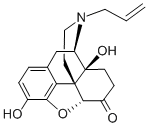M7118748
Naloxone , >97% , 465-65-6
Synonym(s):
(5α)-4,5-Epoxy-3,14-dihydroxy-17-(2-propen-1-yl)morphinan-6-one
CAS NO.:465-65-6
Empirical Formula: C19H21NO4
Molecular Weight: 327.37
MDL number: MFCD00242634
EINECS: 207-365-7
| Pack Size | Price | Stock | Quantity |
| 5mg | RMB569.60 | In Stock |
|
| 25mg | RMB990.40 | In Stock |
|
| 100mg | RMB1764.00 | In Stock |
|
| 500mg | RMB6240.00 | In Stock |
|
| others | Enquire |
Update time: 2022-07-08
PRODUCT Properties
| Melting point: | 184° (Lewenstein), 177-178° (Sankyo Co.) |
| alpha | D20 -194.5° (c = 0.93 in CHCl3) |
| Boiling point: | 465.27°C (rough estimate) |
| Density | 1.2223 (rough estimate) |
| refractive index | 1.5000 (estimate) |
| Flash point: | 9℃ |
| storage temp. | 2-8°C |
| solubility | Chloroform (Slightly, Heated, Sonicated), DMSO (Slightly), Methanol (Slightly), |
| form | Solid |
| pka | pKa 7.94/7.82(H2O,t =20/37,I<0.01) (Uncertain) |
| color | White to Off-White |
| InChIKey | UZHSEJADLWPNLE-GRGSLBFTSA-N |
| EPA Substance Registry System | Morphinan-6-one, 4,5-epoxy-3,14-dihydroxy-17-(2-propenyl)-, (5.alpha.)- (465-65-6) |
Description and Uses
It is worth mentioning that N-allylic substitution in a number of morphine derivatives, as a rule, leads to antagonistic properties. Naloxone is a few times stronger than nalorphine as an antagonist. It blocks opiate receptors. It eliminates central and peripheral action of opioids, including respiratory depression. Naloxone is used upon overdose of narcotic analgesics.
Naloxone is a specific opioid antagonist. Narcotic antagonist.
Safety
| Symbol(GHS) |  GHS07 |
| Signal word | Warning |
| Hazard statements | H302 |
| Precautionary statements | P264-P270-P301+P312-P501 |
| Hazard Codes | F,T |
| Risk Statements | 11-23/24/25-39/23/24/25 |
| Safety Statements | 7-16-36/37-45 |
| RIDADR | UN1230 - class 3 - PG 2 - Methanol, solution |
| WGK Germany | 3 |
| HS Code | 2939190000 |
| Hazardous Substances Data | 465-65-6(Hazardous Substances Data) |
| Toxicity | An opiate antagonist devoid of agonist activity except for mild, specific effects at very high doses. Naloxone displays a high affinity for the μ-opioid receptor, a lesser affinity for the kopioid receptor and has some affinity for δ-opioid receptor subtypes. Naloxone produces a rapid and profound reversal of the effects of opioid administration (e.g., 1 mg, i.v., blocks the effects of 25 mg of heroin). Naloxone also antagonizes the analgesia induced by placebo, acupuncture, and stress, and in animals the hypotension due to hypovolemia or spinal cord injury. Naloxone has a short half-life (about 1 h in plasma) and is not administered orally because of rapid, “first-pass” metabolism. |




